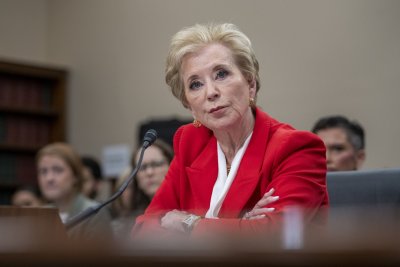
May 21 (UPI) — Education Secretary Linda McMahon, testifying before a House subcommittee on Wednesday, defended a 15.3% leaner budget from last year as part of the department’s “final mission.”
President Donald Trump‘s budget request would cut funding to the Education Department by about $12 billion to wind down the agency. The House bill allocated $30.9 billion and the Senate version $31.9 billion.
She said her top priorities are support for charter schools, which would receive a $60 million funding increase, as well as improving literacy rates and returning education to states. Charters schools are the only ones with a budget funding rise.
“The fiscal year ’26 budget will take a significant step toward that goal,” McMahon told legislators on the House Committee on Appropriations’ education subcommittee. “We seek to shrink federal bureaucracy, save taxpayer money and empower states who best know their local needs to manage education in this country.”
As Republicans supported her plans, Democrats blasted her.
“By recklessly incapacitating the department you lead, you are usurping Congress’ authority and infringing on Congress’ power of the purse,” Rosa DeLauro, of Connecticut, the top Democrat on the appropriations committee, said.
She decried cuts for higher education.
“Your visions for students aspiring to access and pay for college is particularly grim,” DeLauro said. “Some families do not need financial assistance to go to college, but that’s not true for the rest.”
Rep. Bonnie Watson Coleman, of New Jersey, also blasted states gaining greater authority.
“I’m asking you, do you realize that to send authority back to the states, to eliminate your oversight, to eliminate your accountability, to eliminate your determination as to resources going to schools that are teaching public schools that are teaching underserved communities, this will result in the very reason that we had to get the involvement of our government in this, and that’s a yes or no,” she said.
“It isn’t a yes or no, but I will not respond to any questions based on the theory that this administration doesn’t care anything about the law and operates outside it,” McMahon responded.
Coleman said: “From the president of the United States conducting himself in a corrupt manner to his family enriching him and himself corruptly … I’m telling you, the Department of Education is one of the most important departments in this country and you should feel shameful [to] be engaged with an administration that doesn’t give a damn.”
McMahon said she is not trying to remove 8% to 10% that goes to states, and instead moving programs to other departments.
She described her agency as a federal funding “pass-through mechanism” and other agencies could take over the job of distributing allocations from Congress.
“Whether the channels of that funding are through HHS [Health and Human Services], or whether they’re funneled through the DOJ (Department of Jusrtice], or whether they’re funneled through the Treasury or SBA [Smal Business Administration] or other departments, the work is going to continue to get done,” McMahon said.
Plans are to move the student loan programs to the SBA, which McMahon was the administrator during the first Trump administration.
The reductions include eliminating two federal programs designed at improving college access for disadvantaged, TRIO, and low-income students, Gear Up, at a cost of $1.6 billion. Also, the federal Work-Study Program would shift responsibility to states, and funding would be eliminated for Supplemental Educational Opportunity Grants to undergraduate students.
And funding would be reduced 35%, or about $49 million, for the already-scaled back Office for Civil Rights, which investigates harassment and discrimination on college campuses and in K-12 schools.
The budget shifts funding from programs supporting diversity, equity and inclusion initiatives.
She said full funding would remain for Title I-A, which allocates funds to schools with the highest percentages of children from low-income families, and those with the Disabilities Education Act for free public education and support services for children with disabilities.
“Here we are today with a Department of Education that was really stood up in 1980 by President Carter,” McMahon said. “We’ve spent over $3 trillion during that time, and every year we have seen our scores continue to either stagnate or fall. It is clear that we are not doing something right.”
On March 20,, Trump signed an executive order directing McMahon to “take all necessary steps to facilitate the closure of the Department of Education.”
Six days earlier, the agency announced a workforce reduction that would cut nearly 50% of employees, 1,315.
The department, already the smallest Cabinet-level agency before the recent layoffs, distributed roughly $242 billion to students, K-12 schools and universities in the 2024 fiscal year. The fiscal year ends Sept. 30.